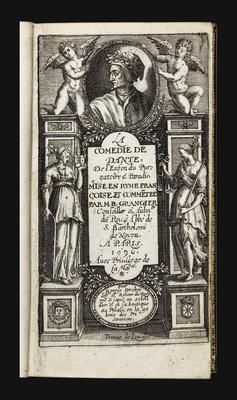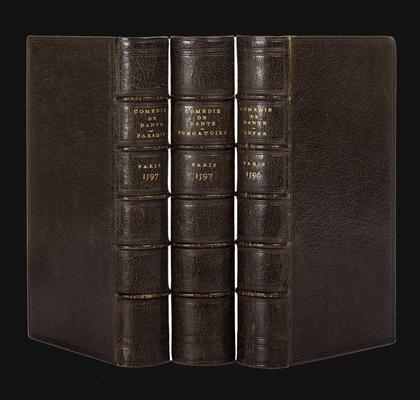Dante Alighieri
La Comedie de Dante, De l’Enfer, du Purgatoire et Paradis. Mise en ryme françoise et commentée par M. B. Grangier Conseiller et Aulm.er du Roys...
Paris, George Drobet [after Jean Gesselin], 1596-1597.Three volumes in 16° (139x75 mm). Collation: A12, Æ2, a¯12, e¯12, ¯6, A-S12; Aa-Zz12, Aaa12, Bbb10; AAa-ZZz12, AAaa-DDdd12, EEee8, FFff4. [86], 438; 587, [1]; 668 pages. Roman, italic and Greek type. Each volume with its own engraved title-page signed by Thomas de Leu (1560-1612), framed within an architectural border containing a portrait of Dante. On fol. a1v of the first volume engraved portrait of Henryivof France, also by de Leu. Woodcut initials, head- and tailpieces. Uniformly bound in early twentieth-century brown morocco, over pasteboards. Spines with five raised bands, title and imprint in gilt lettering. Marbled pastedowns and flyleaves, inside dentelles, green silk bookmarks. Gilt edges. A fine copy, carefully washed and pressed.
Provenance: the French theologian Pierre Morestel (1575-1658; ownership inscription readable under UV lamp on fol. Aa2r of the second volume); Pierre Berès, Paris (small label on the front pastedown of the first volume); Livio Ambrogio collection.
A fine copy of the first printed translation into French of the Commedia, in alexandrine verses by the royal almoner Balthazar Grangier de Liverdis (d. 1606), abbot of Saint-Barthélemy de Noyon, who dedicated his work to the King, Henriivof Navarre. Although already at the beginning of the fifteenth century passages from the Commedia had been echoed in the works of Christine de Pisan – especially her Chemin de long estude (1402-1403), and Le livre de la cité des Dames (1405) – and later, in 1494, the French invasion of Italy had encouraged a manuscript circulation of Dante's text in France (a now-lost bilingual Commedia belonged to the library of Marguerite de Navarre), in the sixteenth century Dante enjoyed little acclaim in France. Among the works by the so-called ‘Three Crowns' Francesco Petrarca's Canzoniere had already been published into French in 1513, while Giovanni Boccaccio's Decamerone had appeared as early as 1485. On the contrary, Dante was almost completely overlooked and the sixteenth-century Lyon editions of the Commedia in Italian – including the early Aldine counterfeit published by Gabiano and Troth in 1502/1503 – appear to have been produced for the large Italian community in the city rather than for a French reading public. Moreover, owing to the extensive popularity of Petrarch's Canzoniere and Trionfi and the growing influence of Petrarchism, together with the vogue for the exquisite ‘crystalline style' of the works of the Pléiade school, in France Dante's style remained out of favour.
During the reign of Henriiv– in 1600 he married Maria de' Medici – Italian influence became particularly strong. Singers, dancing masters, troupes of actors and musical virtuosi from Italy swarmed to the French court. It was in this cultural context that Grangier's decision to publish the first complete French translation of the Commedia emerged. In his preface Grangier points out the difficulties he has encountered in translating Dante's terzine, on account of the Italian poet's ‘pietrosità' or ‘harshness' in language and style. His attempt to promote Dante apparently had very little impact, and Grangier's contemporaries disdained his version: only in 1776 did a new French translation of the Commedia appear.
A further point of interest of the present copy lies in its earliest recorded ownership: the volumes belonged to the French theologian Pierre Morestel, author of works on the Kabbalah and Lullism.



